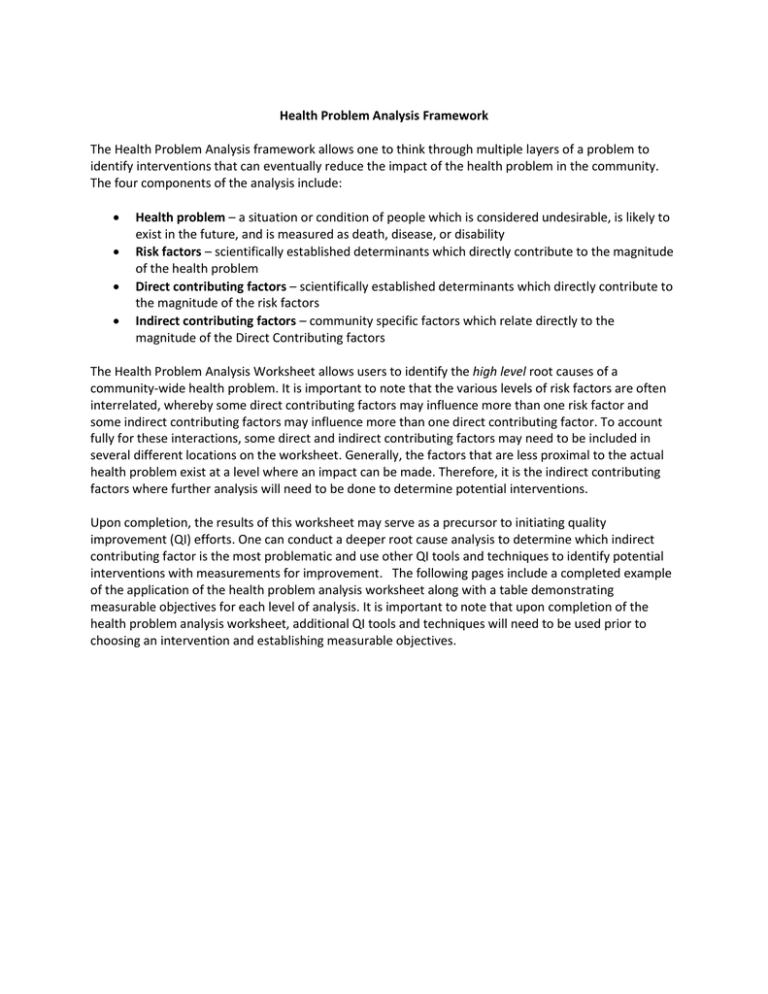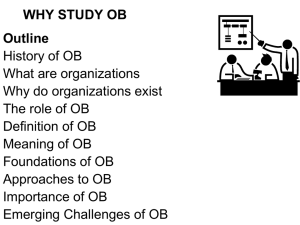Health Problem Analysis Framework The Health Problem Analysis
advertisement

Health Problem Analysis Framework The Health Problem Analysis framework allows one to think through multiple layers of a problem to identify interventions that can eventually reduce the impact of the health problem in the community. The four components of the analysis include: Health problem – a situation or condition of people which is considered undesirable, is likely to exist in the future, and is measured as death, disease, or disability Risk factors – scientifically established determinants which directly contribute to the magnitude of the health problem Direct contributing factors – scientifically established determinants which directly contribute to the magnitude of the risk factors Indirect contributing factors – community specific factors which relate directly to the magnitude of the Direct Contributing factors The Health Problem Analysis Worksheet allows users to identify the high level root causes of a community-wide health problem. It is important to note that the various levels of risk factors are often interrelated, whereby some direct contributing factors may influence more than one risk factor and some indirect contributing factors may influence more than one direct contributing factor. To account fully for these interactions, some direct and indirect contributing factors may need to be included in several different locations on the worksheet. Generally, the factors that are less proximal to the actual health problem exist at a level where an impact can be made. Therefore, it is the indirect contributing factors where further analysis will need to be done to determine potential interventions. Upon completion, the results of this worksheet may serve as a precursor to initiating quality improvement (QI) efforts. One can conduct a deeper root cause analysis to determine which indirect contributing factor is the most problematic and use other QI tools and techniques to identify potential interventions with measurements for improvement. The following pages include a completed example of the application of the health problem analysis worksheet along with a table demonstrating measurable objectives for each level of analysis. It is important to note that upon completion of the health problem analysis worksheet, additional QI tools and techniques will need to be used prior to choosing an intervention and establishing measurable objectives. Direct Contributing Factors Tobacco & substance abuse Risk Factors Indirect Contributing Factors Inadequate access to treatment Lack of education Poverty Low WIC participation Poor nutritional status Low BMI Obesity Prematurity Lack of timely and adequate prenatal care Uninsured/Underinsured Lack of transportation Cultural beliefs High rate of teen pregnancy Lack of knowledge Inadequate OB access Lack of transportation Poor nutritional status Low BMI Low WIC participation Obesity Health Problem Infant Mortality Low birth weight Preconceptional Health Chronic illness Hypertension Diabetes Anemia Table 1: Measurable Objectives Level of Analysis Present Measure Measurable Objective Health Problem: Infant mortality 12/1000 live births per year Risk Factor: Low birth weight 90/1000 live births per year Direct Contributing Factor: Lack of timely and adequate prenatal care 60% of pregnant women receive prenatal care during the first trimester of pregnancy Indirect Contributing Factor: Accessibility of prenatal clinics 25% of prenatal clinics are accessible by public transportation Outcome objective: Decrease infant mortality rate to no more than 8/1000 live births per year by December 31, 2020 Impact objective: Decrease low birth weight to 70/1000 live births per year by December 31, 2015 Process objective: Increase the number of pregnant women that will have received prenatal care during the first trimester of pregnancy to 80% by December 31, 2013 Process objective: Increase the number of prenatal clinics that are accessible by public transportation to 60% by December 31, 2012. Direct Contributing Factors Risk Factors Health Problem Indirect Contributing Factors


